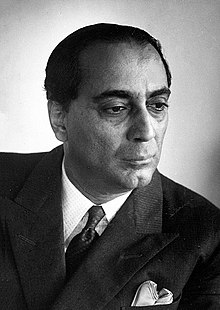Homi J. Bhabha | |
|---|---|
 Bhabha c. 1960s | |
| Chairperson of the Atomic Energy Commission of India | |
| In office 1948–1966 | |
| Preceded by | position established |
| Succeeded by | Vikram Sarabhai |
| Personal details | |
| Born | 30 October 1909 Bombay, Bombay Presidency, British India |
| Died | 24 January 1966 (aged 56) Mont Blanc massif, France |
| Cause of death | Air India Flight 101 crash |
| Relatives | |
| Alma mater | University of Cambridge (BS, PhD) |
| Known for |
|
| Awards | Adams Prize (1942) Padma Bhushan (1954) Fellow of the Royal Society[2] |
| Scientific career | |
| Fields | Nuclear physics |
| Institutions | |
| Doctoral advisor | Ralph H. Fowler |
| Other academic advisors | Paul Dirac |
Homi Jehangir Bhabha, FNI,[3] FASc,[1] FRS[4](30 October 1909 – 24 January 1966) was an Indian nuclear physicist who is widely credited as the "father of the Indian nuclear programme". He was the founding director and professor of physics at the Tata Institute of Fundamental Research (TIFR), as well as the founding director of the Atomic Energy Establishment, Trombay (AEET) which was renamed the Bhabha Atomic Research Centre in his honour. TIFR and AEET served as the cornerstone to the Indian nuclear energy and weapons programme. He was the first chairman of the Indian Atomic Energy Commission and secretary of the Department of Atomic Energy. By supporting space science projects which initially derived their funding from the AEC, he played an important role in the birth of the Indian space programme.
Bhabha was awarded the Adams Prize (1942) and Padma Bhushan (1954), and nominated for the Nobel Prize for Physics in 1951 and 1953–1956. He died in the crash of Air India Flight 101 in 1966, at the age of 56. The mysterious circumstances of his death has led to the rise of several conspiracy theories claiming he was assassinated.
- ^ a b "Homi Jehangir Bhabha". Indian Academy of Sciences. Retrieved 4 August 2023.
- ^ Penney, L. (1967). "Homi Jehangir Bhabha 1909-1966". Biographical Memoirs of Fellows of the Royal Society. 13: 35–55. doi:10.1098/rsbm.1967.0002. S2CID 72524347.
- ^ "Deceased Fellow: Prof. Homi Jehangir Bhabha". Indian National Science Academy. Retrieved 4 August 2023.
- ^ Penney, William George (1967). "Homi Jehangir Bhabha, 1909–1966". Biographical Memoirs of Fellows of the Royal Society. 13: 41. doi:10.1098/rsbm.1967.0002. ISSN 0080-4606. S2CID 72524347.